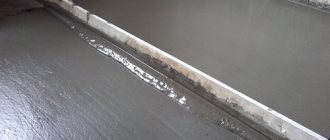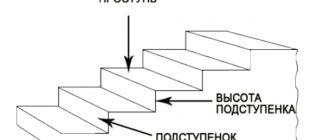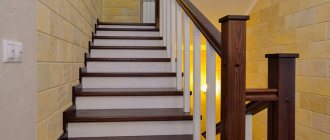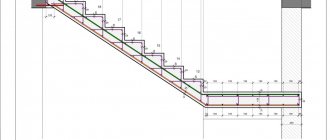Concrete is reinforced with reinforcement to increase the wear resistance of the structure. A monolithic concrete structure is characterized by increased strength; such a surface is suitable for most finishing materials. Drawings are needed for high-quality performance of all subsequent work.
Concrete staircase in the house Source olestnicah.ru
Why is a metal frame installed?
Reinforcing the landing increases the strength and increases the service life of the concrete structure. The load acts on the metal frame, which distributes it throughout the structure. Concrete is reinforced with reinforcement during the construction of foundations, ceilings, arches, and stairs.
Monolithic flight of stairs Source bac9.ru
The metal frame allows:
- reduce the likelihood of cracks;
- increase the service life of the structure;
- create individual elements that can be mounted separately and transported.
Concrete stairs are erected during the construction of the entire building, this simplifies construction work. Reinforced concrete structures of various shapes allow you to realize original ideas.
Attention! On stairs that are not reinforced with reinforcement, cracks form under the influence of various factors.
The main load falls on the steps, but the supporting platform is most susceptible to tensile loads.
Staircase with glass support Source burolestnic.ru
Monolithic construction has a number of other advantages:
- Increased strength. Only periodic updating of decorative elements is required.
- Resistant to high humidity and temperature changes.
- Has increased sound insulation properties.
- The metal frame significantly increases the strength of the concrete staircase.
- Affordable price.
Metal staircase on stringers
After all, the design must fit the parameters of the space allocated for the stairs. A ladder on metal stringers will help even inexperienced craftsmen complete the installation task.
The main thing is to correctly make drawings of the stairs with a mark of the place where the gangway will be located. And also have on hand the tools and materials necessary to implement this idea in your own home.
Advantages
Due to the fact that gangways equipped with stringers have earned their vocation, the positive aspects of this solution are obvious:
- This makes the work process easier;
- Allows you to easily organize the order of actions;
- Such structures are strong and durable;
- Thanks to stringers, even an inexperienced specialist or just a home owner will be able to realize his plans and make them a reality;
- This element allows you to devote more time to details and design experiments that will decorate the staircase project to the second floor.
These are not all the positive aspects of staircases on stringers; each owner of a private house finds his own independent advantages.
Flaws
It is necessary to correctly determine the size of the base for the steps so that the structure fits clearly into the interior. It is not difficult to make such calculations. Simply measure the height, angle and width of the required installation.
The procedure for filling the formwork:
Disadvantages of reinforced stairs
Reinforced concrete structures have many advantages compared to stairs made of other materials. When choosing a suitable material, it is worth familiarizing yourself with the disadvantages of reinforced concrete stairs:
- high labor intensity of work during the construction of the structure;
- installation requires the use of lifting equipment;
- increased weight of the stairs - additional load for walls and ceilings;
- the need for additional finishing work.
Staircase landing in a country house Source lestnitsygid.ru
Despite the above characteristics, reinforced stairs are in demand in the construction of buildings for various purposes.
How to build a staircase?
When designing a staircase, it is important to maintain the correct proportions.
Today, many people prefer to build country houses according to individual drawings. Often, after weighing all the pros and cons, owners of a plot of land decide to opt for reinforced concrete stairs. Some of them are starting to build steps with their own hands. However, it is necessary to take into account that before starting installation, you should make calculations and draw up a drawing, which will take into account all the dimensions and parameters of the steps . In order to get the optimal result, you need to act in stages. Before you start working on the stairs, you must:
- make calculations of the dimensions of steps, supports and other elements;
- install wooden formwork;
- place a metal frame (reinforcement);
- pour concrete solution.
All parameters are indicated in the drawing. The implementation of the above stages consists of a number of important nuances that should be taken into account, because the final result of construction will depend on them. However, as practice shows, correct calculation, compliance with the rules and values indicated in the drawing, will allow you to make high-quality steps on stringers with your own hands.
Return to contents
Basic rules, the implementation of which will strengthen the monolithic staircase landing
When designing, the most important thing is the accurate calculation of loads. The load impact point is below the central part of the flight. The main load is experienced by the steps of the stairs, but tensile loads have the greatest impact on the span and the supporting platform. Concrete can withstand a certain level of loads up to a certain point, after which cracking occurs in the place experiencing a tensile load, and the destruction of the entire structure.
Reinforcement frame for concrete stairs Source drive2.ru
Stages of staircase construction
During the construction of a concrete staircase, it is important to follow the technology for each stage. First, the calculations are performed. Then step by step:
- install formwork;
- knit and fix the reinforcing frame of the flight of stairs;
- step formwork is installed;
- reinforce the steps;
- carry out quality control and install additional formwork fasteners;
- concrete the structure;
- care for concrete;
- dismantle the formwork;
- perform cladding.
Installation of formwork
To install the formwork, take wooden boards or plywood sheets. They are additionally covered with a thick film to protect them from rain and other moisture. The rods are fastened with dotted film or wire. The formwork parts are connected using screws and self-tapping screws.
But such fastening is done manually only if the scope of work is minimal. To build large-scale capital structures, pieces of annealed wire cut and collected into bundles are used.
Marking
Depending on the size of the doorway, you need to calculate the height and width of the steps and their number. Each of them must have the same parameters. The most difficult thing to work with is triangular steps, since their width is calculated differently than the dimensions of rectangular ones. After making the calculation, you need to have measurements on hand to check the values. In addition, you should take into account the height of the floor on all floors and the size of the material with which you will finish the flight of stairs.
Return to contents
Mounting options
The following installation options are used to link nodes:
- double row;
- cross;
- angular;
- meter knot.
To make the job easier, attach a homemade or purchased hook to the screwdriver. Or special nippers. Next, the cross-sectional length of the reinforcement is multiplied by 50. The resulting figure is the length that reflects the overlap that needs to be made when laying the reinforcement together. The elements are connected with strong wire.
Scheme of reinforcement of the staircase landing Source revitcity.ru
Reinforcement provides a mesh at the top and bottom. The modules are welded or welded together.
Finish lining
A DIY concrete staircase can have different finishing options: wood, laminate, tiles, carpet, acrylic stone or porcelain stoneware. Any material must be laid on a level base. After dismantling the formwork, uneven areas may remain on the site, which are recommended to be removed by sanding and plastering. The end parts are usually finished with plaster and painted. After this, the steps are covered with one of the materials.
The surface can be covered with tiles, artificial or natural stone with a rough surface. The material is laid on cement mortar or tile adhesive. Using the same technology, mosaics are laid, creating original compositions from small elements.
Photo instructions for installing clinker steps
The finishing can be done with wood panels that are resistant to abrasion. For this purpose, larch and exotic species that have undergone antiseptic treatment are selected.
Installation of larch wood cladding
An excellent treatment option is laminate, which is abrasion-resistant, easy to install and durable.
Installation of special stair laminate
If children or elderly people live in the house, then you can choose carpet, available in different colors.
The final stage is finishing with carpet
To save money, you can simply paint the steps with high-quality concrete paint.
Painting is a cheap but interesting option
In any case, the appearance of the staircase is associated with the taste preferences and financial capabilities of the owner.
Types of power elements
To make the stairs even stronger, two reinforcement options are used:
- Grids. They come in different wire thicknesses. They are tied by hand or by welding.
- Frame flat gratings. They are manufactured industrially. When working to strengthen stairs, the gratings are welded and, in exceptional cases, tied together by hand.
Monolithic staircase in the house Source of stairs-for-home.rf
The load on concrete stairs is directed from above, so reinforcement begins from the very bottom. 20 cm is the classic height of concrete stairs. Therefore, the clamps must be at least 10 cm. To connect the meshes to each other, special hooks are used.
Choice of design and types of stairs
It is necessary to draw a detailed project and carry out all the calculations. If a simple type of structure is selected, which will be located between two walls, then the drawings can be applied directly to the walls. The project takes into account the dimensions and installation locations of railings or other fences.
According to building codes, the width of the stairs must be at least 80 cm. The standard height of steps is 17 cm, width is 30 cm, so that the step is comfortable. When calculating the height, you need to take into account the future height of the finishing coating (the entire pie) of the floor.
The angle of inclination of the stairs to the second floor is selected in the range from 30° to 45°. 30° is considered the best option, since going up and down it will be as comfortable as possible. An angle of 45° is made when it is necessary to save space, for example, in a small private house. It is not recommended to build it even steeper, as it will become unsafe.
You can pour a staircase for a private house yourself during its construction or buy a prefabricated one. The latter option is delivered ready-made to the construction site and assembled on site. It can also be made from combined materials: the stringer is made of metal, and the steps are made of concrete.
According to the type of staircase design, there are the following:
- outsiders;
- screw;
- with straight march;
- two-flight with a platform.
Straight one-march is the simplest type. Connects the first and second floors without bends, just straight. Screw ones are installed if the house has a small area. Winder stairs are structures that have winder steps and one or more turns (bends). They are also installed when it is necessary to save space, since they do not require arrangement of the site.
This is a minimum set of accessories that will help you carry out the measurement process efficiently and quickly.
Drawings for reinforcement of monolithic stairs
Tensile loads and torques contribute to the loss of material integrity. Concrete absorbs large compressive loads per unit area.
The calculation of the circuit should be carried out by a specialist, or, if you decide to do this work yourself, you need to use an example of the calculation and then get advice from an experienced specialist.
Thanks to the calculations, a drawing will be drawn up and the quantity and type of reinforcement will be determined, the need for reinforcement of the steps, the method of connecting the flight and the platform, and the method of tying the reinforcement.
Drawing for reinforcement of concrete stairs Source revitcity.ru
Finishing
A flight of stairs made of reinforced concrete is popular not only due to its durability and reasonable cost. In addition, you can change the design of products made from building materials. Handrails and railings in different styles are successfully combined with such designs. There are several types of product finishing:
- Classical. Wood is used to design monolithic steps. The wood finish puts little stress on the staircase and blends harmoniously with the forged handrails.
- A flight of stairs will look impressive if special lighting is built into the steps.
- Wooden steps will successfully complement the stringers.
- The flight of stairs can also be tiled.
Basic principles of reinforcement and pattern creation
The span is a self-supporting structure; if the rotation of the flight exceeds 180 degrees, additional support should be installed. Loads can be compensated by columns and wall fastenings. ST-5 rods are used, they are laid with a pitch size of 12, 16,18 and 20 with a rod cross section of 1, 1.2-1.4, 1.6 and 1.8, respectively.
The frame is assembled in increments of 22-30 cm, the reinforcement increment is 20 cm. The reinforcement fixed to the embedded units serves as a support and prevents the formation of cracks. The drawing must take into account the rigid fastening of the stairs to the ceiling; for this purpose, the embedded rods are extended to 7-8 cm.
The rods are placed on clamps without a gap, so that they form a mesh. As the length of the staircase increases, another row of rods is installed; they are placed longitudinally, 5 cm above the main part.
There is no need to reinforce the steps, but to prevent chipping, it is worth laying a 0.4x5 cm mesh under a layer of concrete material.
Reinforcement of a monolithic concrete staircase Source of stairs-for-home.rf
The drawings allow you to make all the necessary calculations, and then begin the sequential execution of construction work.
How to make a backfill monolithic staircase with a platform with your own hands
The construction of a cast-in-place monolithic staircase is a simple and reliable solution for a massive porch or a separate entrance to a building. You can make such a staircase with your own hands without any special knowledge or skills. All you need is desire and a minimum set of tools.
Design
A monolithic infill staircase consists of a rigid box made of brick or cinder block, a platform and a flight of stairs. The space under future steps is filled in advance with sand, slag or simply excess soil.
Such a staircase does not require additional formwork and supporting structures under the flight. It has exceptional strength and reliability due to the fact that it rests entirely on a prepared base.
A strip reinforced concrete foundation (300–400 mm thick) is installed under the walls of the box. Optimal dimensions in plan: flight length 3 m (10 steps of 300 mm each), width from 1 to 1.5 m. Step size 300x150 mm.
Where to begin
To carry out the work, you will need the usual set of tools: a concrete mixer, a hammer drill, an angle grinder, a 90° square, threads, a rule of 2 m, a hydraulic level.
Materials (based on 10 steps and 1 m platform, 1 m wide, two side walls):
· brick - 2 m3 (cinder block 1.8 m3)
· soil or sand for backfilling - 3.6 m3
· concrete – 4 m3
· fittings (12) – 100 linear m
· welded masonry mesh 50x50, 3 mm – 10 m2
Examples of staircase locations. 1 - doorway; 2 - platform; 3 — brick (cinder block); 4 - backfill (sand, soil); 5 — staircase body; 6 - foundation of supporting walls; 7 - supporting wall; 8 - node A; 9 - node B
The amount of consumables will change in proportion to the number of steps (lift height).
Support walls
There is no need to pour a foundation for the entire area of the stairs! The laying of supporting walls on a strip foundation for waterproofing is carried out with a thickness of one brick (one of the walls will always be the wall of the building).
It is necessary to anchor reinforcement (wire) into a static wall and lay reinforcing mesh or wire every 4-5 rows, especially in the corners (the walls will have to withstand the load from backfilling and compaction). It is advisable to apply liquid waterproofing from the inside.
The finished walls should not be lower than the future steps; their continuation can be an element of the porch architecture (pillars, railings, etc.).
Marking
The size of the staircase is calculated from top to bottom from the doorway. For marking you will need a 90° pattern. You can make it by attaching a small level to the long side of a regular steel square (with dimensions of at least 300x150 mm):
· Determine the level of the finished floor (surface of the finishing material) of the staircase landing.
· We determine the level of the site “by concrete” - subtract the thickness of the finishing layers. This will be the horizon of the site.
· We determine the location of the site relative to the doorway (centering, offset - depending on the purpose of the porch). Finding the extreme points.
If the staircase runs along the wall, from the extreme point vertically downwards we set aside 150 mm downwards. This is the last riser - part of the site. If the staircase goes “forward” from the opening, we place the extreme points on the supporting walls, having previously marked the horizon of the site on them.
Next, using a pattern, we set aside and outline the steps downwards, focusing on the level readings. Then we connect the lower corners along the march with a line. From this line we lay a perpendicular down 100 mm and draw a parallel line. The space between these parallels is called the “body of the staircase.” The lower one will be the boundary of the backfill.
Backfill
Backfilling of the staircase cavity is carried out strictly no earlier than 3 days after laying the supporting walls! Filling the sinus is carried out in layers (300–400 mm) with compaction of each layer. A manual tamper can be made by attaching door handles to the end of a stump with a diameter of 20–30 cm. Operate the tamping machine no closer than 300 mm from the wall.
When using sand as a sinus filler, spilling with water is allowed (afterwards leave for 24 hours). Waterproofing (usually polyethylene, geotextile or vapor barrier) is laid on top of the backfill so that the concrete does not mix with the soil and does not lose its qualities.
Reinforcement frame structure
To tie reinforcement with knitting wire, you will need a hook, which can be made by sharpening and bending 6 or 8 mm wire into a convenient shape.
The reinforcement of the foundation under the supporting walls is done in the form of a beam frame - 4 working rods, distributed in space with clamps or short vertical rods.
The reinforcement frame of the staircase consists of a mesh at the base (reinforcement 12) and a mesh along the steps themselves (welded mesh 50x50, 3 mm).
To install the main working grid in the middle of the staircase body and landing, we anchor the reinforcement in a mirror manner with a step of 200 mm. We tie rods to the outlets with a length equal to the width of the stairs. Then we measure the length of the landing + flight and bend the solid rods to the angle of the flight and install them in increments of 200 (there will be 6 pieces per 1 meter of staircase width).
To reinforce the steps, we bend the welded mesh in the shape of the letter L and fasten it to the main mesh with knitting wire.
Attention! Consider a protective layer of concrete of 30–40 mm (from the reinforcement to the concrete surface)!
1 - welded mesh; 2 - transverse rods anchored into the supporting walls (pitch 200 mm); 3 - longitudinal reinforcement; 4 - thrust beam 1st stage
For the top layer of reinforcement of the site, we anchor the reinforcement (2-3 rods on each side) below the horizon by 40 mm and tie a sheet of welded mesh onto them.
Step edging
To edge the steps, we make risers, usually this is a strip of plywood with a width equal to the height of the step, sewn onto a 40–50 mm board. Either corners or bars are attached to the edges. The risers are attached according to the markings to the supporting walls of the staircase using “quick installation” dowels or any other available method. It is advisable to lubricate the plywood with used machine oil (this will make disassembly easier). Then, along the flight, along the top of all flanges, a solid board of 25–40 mm is sewn, always with a stop at the bottom (to maintain the size). If the staircase width is more than 1.2 m, 2 boards are installed.
Fill
For better results (quality of dry concrete) and ease of laying the mixture, we recommend using an in-depth vibrator (vibrating head with a diameter of 40 mm). Concrete is laid in the stairs from bottom to top. The concrete should be “steep” (dry) so that it does not leak through the treads.
When vibrating, concrete “sits”, filling the voids, so it is better to lay it in steps “with a slide” for the entire flight at once. Vibration should start from top to bottom. This will remove excess concrete from the steps. The platform is laid and vibrated last. The surface of the concrete is smoothed with trowels and trowels.
Attention! Remove all excess concrete from the formwork while it is wet.
Cover the flooded staircase with polyethylene (especially in hot weather). Carefully remove the step flanging after 24 hours.
Vitaly Dolbinov, rmnt.ru
https://www.rmnt.ru/ - website RMNT.ru
Pouring concrete
Pouring concrete is carried out in one stage. To complete the work, concrete class B30 and higher will be required. To the required volume of material you need to add 10% (the amount of losses during transportation). First, fill the lower steps with the solution, then the upper ones. During pouring, concrete must be compacted and then treated with vibration. Topping up the solution will allow you to get rid of material subsidence. A concrete staircase completely hardens in 2 weeks; during this time, the structure must be periodically moistened to prevent the formation of cracks. After the structure has completely hardened, the formwork is dismantled and finishing is carried out.
Reinforcement of concrete stairs Source vid-vip.ru
Advantages of concrete structures
Various materials can be used to construct step transitions. Constructions made of metal and building wood are quite popular.
How does a staircase made of monolithic concrete differ from similar structures on other bases? The main advantage of monolithic construction is a high degree of strength and at the same time the ability to create elements that are complex in shape and design.
In addition, concrete stairs have the following advantages:
- Concrete is environmentally friendly and non-flammable.
- The material is not subject to rotting and is not afraid of insects.
- The cement-based structure is physically stable, which means that even over time, extraneous noise (creaks) will not appear.
- Chips, small cracks, and peeling on reinforced concrete steps can be easily repaired yourself.
- Almost any decorative material is suitable for cladding concrete stairs.
Any design has disadvantages. For concrete stairs, the main disadvantage is weight. The construction of a monolithic staircase requires a very strong foundation, as well as a serious foundation for attaching the upper part.
Regardless of the shape of the steps, concrete monolithic stairs are highly durable structures











